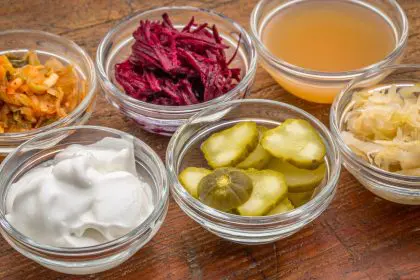That morning pastry habit might contribute more to recurring infections than you realize. Medical professionals at Mayo Clinic note that high-sugar foods create perfect conditions for yeast overgrowth in your body. This includes obvious treats like candy and soda, but also sneaky sources like flavored yogurt and breakfast cereals.
Understanding the carb effect
Those white bread sandwiches and pasta dinners might taste delicious, but they could fuel unwanted yeast growth. Medical researchers explain that refined carbohydrates quickly convert to sugar in your body, creating an environment where yeast thrives.
The probiotic protection factor
Adding specific foods to your daily menu can help prevent future infections. Fermented foods like plain yogurt, kefir, and kombucha introduce beneficial bacteria that help maintain healthy yeast levels. Medical experts recommend incorporating at least one serving of these foods daily.
Hidden food triggers to consider
Food sensitivities might play a bigger role than previously thought. Medical professionals at Cleveland Clinic report seeing increased yeast infection cases among patients with unidentified food allergies. Common culprits include dairy, gluten, and processed soy products.
The inflammation impact
Many people don’t realize that certain foods trigger internal inflammation, creating perfect conditions for yeast overgrowth. Dr. Sarah Bennett at New York University’s Department of Nutrition studies this connection, finding that processed foods and artificial sweeteners often contribute to the problem more than natural sugars.
Nature’s defenders on your plate
Medical research points to specific foods that actively fight against yeast overgrowth. Garlic, for example, contains natural compounds that help maintain healthy yeast levels. Coconut oil, with its unique fatty acids, also shows promising results in supporting balanced internal flora.
The hydration factor
While most people focus on food choices, beverage selections play an equally important role. Medical experts recommend replacing sweetened drinks with water infused with lemon or lime, which naturally supports your body’s pH balance. Green tea, known for its antioxidant properties, might also help maintain healthy yeast levels.
Understanding your gut’s ecosystem
Recent medical studies reveal that your digestive system houses a complex community of microorganisms that influence yeast growth. Eating a diverse range of colorful vegetables helps support this internal ecosystem. Think rainbow on your plate: red peppers, orange carrots, green leafy vegetables, and purple cabbage.
The protein puzzle
Your protein choices might affect yeast growth more than previously thought. Medical professionals suggest choosing lean proteins like chicken, fish, and legumes over processed meats that often contain added sugars and preservatives. These cleaner protein sources help maintain a balanced internal environment.
Timing matters
Medical experts now recognize that when you eat certain foods matters almost as much as what you eat. Late-night sugary snacks prove particularly problematic, as your body processes sugars differently during sleeping hours.
The stress connection
While not directly food-related, stress affects how your body processes nutrients. High-stress levels can trigger sugar cravings, leading to food choices that promote yeast growth. Medical professionals recommend mindful eating practices alongside stress-management techniques.
Building a preventive meal plan
Creating a yeast-friendly eating schedule doesn’t mean eliminating all enjoyable foods. Instead, medical experts suggest building meals around vegetables, lean proteins, and whole grains, while treating sugar-rich foods as occasional indulgences rather than daily staples.
The supplement situation
While food should remain your primary focus, certain supplements might help maintain healthy yeast levels. However, medical professionals emphasize consulting healthcare providers before starting any supplement regimen, as some supplements interact with medications.
Reading food labels effectively
Understanding food labels helps identify hidden ingredients that might contribute to yeast overgrowth. Manufacturers often use different names for sugar, including dextrose, maltose, and corn syrup. Learning these alternative terms helps make informed food choices.
The exercise equation
Physical activity influences how your body processes sugars and maintains internal balance. Regular movement helps regulate blood sugar levels, potentially reducing conditions that promote yeast growth. Even moderate activities like walking provide benefits.
Long-term lifestyle changes
Creating lasting dietary changes requires patience and planning. Medical experts suggest starting with small modifications rather than dramatic overhauls. This approach proves more sustainable and often leads to better long-term results.
Understanding your personal triggers
Each person responds differently to various foods. Keeping a detailed food diary helps identify personal trigger foods that might contribute to recurring infections. This personalized approach often proves more effective than following generic dietary advice.
When to seek professional help
While dietary changes often help reduce infection frequency, persistent issues require medical evaluation. Healthcare providers can investigate underlying conditions that might contribute to recurring infections, ensuring comprehensive treatment approaches.
Planning for success
Medical experts recommend preparing weekly meal plans that emphasize yeast-fighting foods. This proactive approach helps avoid impulse food choices that might contribute to infections. Consider batch-cooking healthy meals and keeping yeast-friendly snacks readily available.
The future of treatment
Emerging research continues revealing new connections between diet and yeast infections. Medical professionals remain optimistic about developing more targeted dietary recommendations based on individual microbiome profiles.
Moving forward with confidence
Understanding the relationship between diet and recurring yeast infections empowers individuals to make informed food choices. While dietary changes alone might not eliminate all infections, they represent a crucial component of comprehensive prevention strategies.
Remember that changing eating habits takes time and patience. Focus on progress rather than perfection, and celebrate small victories along the way to better health. Working with healthcare providers ensures that dietary modifications complement other treatment approaches effectively.













